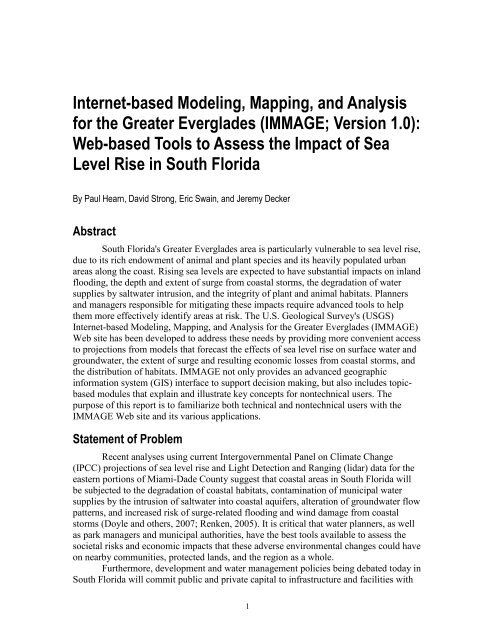Report PDF (3.7 MB) - USGS
Report PDF (3.7 MB) - USGS
Report PDF (3.7 MB) - USGS
Create successful ePaper yourself
Turn your PDF publications into a flip-book with our unique Google optimized e-Paper software.
Internet-based Modeling, Mapping, and Analysis<br />
for the Greater Everglades (IMMAGE; Version 1.0):<br />
Web-based Tools to Assess the Impact of Sea<br />
Level Rise in South Florida<br />
By Paul Hearn, David Strong, Eric Swain, and Jeremy Decker<br />
Abstract<br />
South Florida's Greater Everglades area is particularly vulnerable to sea level rise,<br />
due to its rich endowment of animal and plant species and its heavily populated urban<br />
areas along the coast. Rising sea levels are expected to have substantial impacts on inland<br />
flooding, the depth and extent of surge from coastal storms, the degradation of water<br />
supplies by saltwater intrusion, and the integrity of plant and animal habitats. Planners<br />
and managers responsible for mitigating these impacts require advanced tools to help<br />
them more effectively identify areas at risk. The U.S. Geological Survey's (<strong>USGS</strong>)<br />
Internet-based Modeling, Mapping, and Analysis for the Greater Everglades (IMMAGE)<br />
Web site has been developed to address these needs by providing more convenient access<br />
to projections from models that forecast the effects of sea level rise on surface water and<br />
groundwater, the extent of surge and resulting economic losses from coastal storms, and<br />
the distribution of habitats. IMMAGE not only provides an advanced geographic<br />
information system (GIS) interface to support decision making, but also includes topicbased<br />
modules that explain and illustrate key concepts for nontechnical users. The<br />
purpose of this report is to familiarize both technical and nontechnical users with the<br />
IMMAGE Web site and its various applications.<br />
Statement of Problem<br />
Recent analyses using current Intergovernmental Panel on Climate Change<br />
(IPCC) projections of sea level rise and Light Detection and Ranging (lidar) data for the<br />
eastern portions of Miami-Dade County suggest that coastal areas in South Florida will<br />
be subjected to the degradation of coastal habitats, contamination of municipal water<br />
supplies by the intrusion of saltwater into coastal aquifers, alteration of groundwater flow<br />
patterns, and increased risk of surge-related flooding and wind damage from coastal<br />
storms (Doyle and others, 2007; Renken, 2005). It is critical that water planners, as well<br />
as park managers and municipal authorities, have the best tools available to assess the<br />
societal risks and economic impacts that these adverse environmental changes could have<br />
on nearby communities, protected lands, and the region as a whole.<br />
Furthermore, development and water management policies being debated today in<br />
South Florida will commit public and private capital to infrastructure and facilities with<br />
1
















